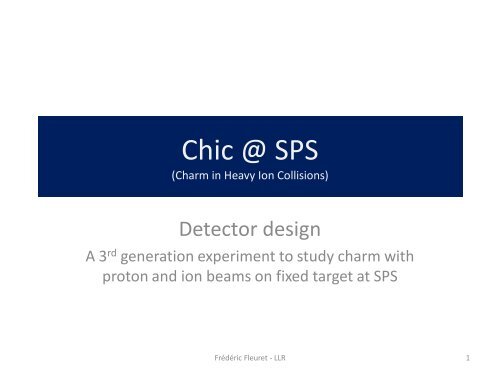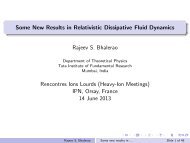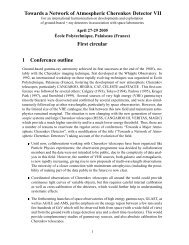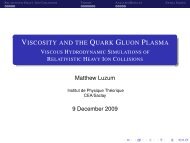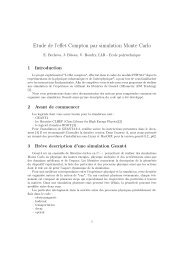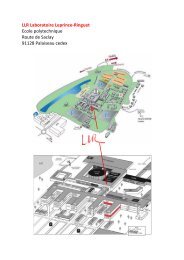Chic @ SPS (Charm in Heavy Ion Collisions)
Chic @ SPS (Charm in Heavy Ion Collisions)
Chic @ SPS (Charm in Heavy Ion Collisions)
Create successful ePaper yourself
Turn your PDF publications into a flip-book with our unique Google optimized e-Paper software.
<strong>Chic</strong> @ <strong>SPS</strong><br />
(<strong>Charm</strong> <strong>in</strong> <strong>Heavy</strong> <strong>Ion</strong> <strong>Collisions</strong>)<br />
Detector design<br />
A 3 rd generation experiment to study charm with<br />
proton and ion beams on fixed target at <strong>SPS</strong><br />
Frédéric Fleuret - LLR<br />
1
Physics motivations – 2 key questions<br />
1. Measure χ c <strong>in</strong> A+A<br />
Similar J/Ψ suppression at <strong>SPS</strong> and RHIC:<br />
1. Either more suppression at RHIC compensated by recomb<strong>in</strong>ation<br />
2. Or J/Ψ suppression due to χ c only sequential suppression<br />
How χ c is suppressed relative to J/Ψ ?<br />
Mandatory to draw the whole picture (<strong>SPS</strong> .vs. RHIC .vs. LHC)<br />
2. Measure charmonia production <strong>in</strong> p+A<br />
what is the depence of charmonia suppression with rapidity ?<br />
Crucial to understand effects due to cold nuclear matter<br />
We need to correctly calibrate our QGP thermometer.<br />
Frédéric Fleuret - LLR 2
1. Measure χ c <strong>in</strong> A+A<br />
Eur. Phys. J. C49 (2007) 559<br />
NA50<br />
Phys. Rev. Lett. 99, 132302 (2007)<br />
NA60<br />
Ψ’<br />
χ c<br />
J/Ψ<br />
χ c<br />
Suppression<br />
?<br />
Direct J/Ψ<br />
Suppression<br />
?<br />
N J/Ψ ~ 60% direct + ~30% from χ c + ~10% from Ψ’<br />
Benchmark: measure χ c <strong>in</strong> PbPb<br />
• at mid-rapidity<br />
• for N part ∈[50;300]<br />
• N part =300 ~10% most central<br />
Frédéric Fleuret - LLR 3
2. Measure charmonia <strong>in</strong> p+A<br />
J/Ψ and Ψ’ suppression <strong>in</strong> p+A<br />
collisions as a function of L<br />
Measur<strong>in</strong>g different charmonium<br />
states gives key <strong>in</strong>formation on<br />
nuclear « absorption » and<br />
production mechanism.<br />
NA50<br />
Ψ’<br />
J/Ψ<br />
Euro. Phys. J. C48 (2006) 329.<br />
J/Ψ rapidity distribution <strong>in</strong> p+A<br />
collisions<br />
Measur<strong>in</strong>g charmonium <strong>in</strong> a wide<br />
rapidity range is mandatory to identify<br />
possible (anti)shadow<strong>in</strong>g effects<br />
Frédéric Fleuret - LLR 4
Experimental landscape<br />
• Current landscape<br />
– Fixed target : <strong>SPS</strong>/CERN NA38/50/60 experiments – √s NN = 17 – 30 GeV<br />
• Statistic :100 000’s J/ψ<br />
• Data sets : p+A w/ A=p, d, Be, Al, Cu, Ag, W, Pb; S+U, In+In, Pb+Pb<br />
• Small rapidity coverage (typically y ∈ [0,1])<br />
– Collider : RHIC/BNL Phenix, Star experiments – √s NN = 200 GeV<br />
• Statistic : 1000’s J/ψ (10000’s s<strong>in</strong>ce 2007)<br />
• Data sets : p+p, d+Au, Cu+Cu, Au+Au<br />
• Large rapidity coverage (y ∈ [-0.5,0.5], y ∈ [-2.2,-1.2] and y ∈ [1.2,2.2])<br />
– Collider : LHC/CERN Alice, CMS, Atlas experiments (√s NN = 5,5 TeV)<br />
• Statistic : 100000’s J/ψ<br />
• Data sets : p+p, Pb+Pb, p+Pb<br />
• Large rapidity coverage (|y|


